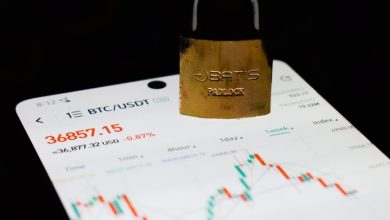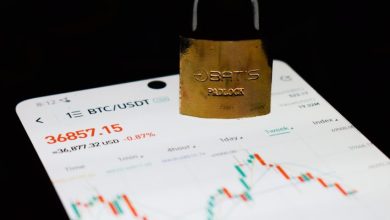Best Practices for Protecting Your Crypto Portfolio from Losses

- Understanding the Risks of Holding Cryptocurrency
- Diversifying Your Crypto Investments for Risk Management
- Implementing Secure Storage Solutions for Your Digital Assets
- Setting Realistic Investment Goals to Avoid Emotional Trading
- Utilizing Stop-Loss Orders to Minimize Losses in Volatile Markets
- Staying Informed About Market Trends and Regulatory Changes
Understanding the Risks of Holding Cryptocurrency
It is important to understand the risks associated with holding cryptocurrency in your portfolio. While the potential for high returns may be enticing, it is essential to be aware of the volatility and security concerns that come with investing in digital assets.
One of the main risks of holding cryptocurrency is the price volatility. Cryptocurrency prices can fluctuate wildly in a short period of time, leading to significant gains or losses. It is crucial to be prepared for this level of volatility and not invest more than you can afford to lose.
Another risk to consider is the security of your cryptocurrency holdings. Due to the decentralized nature of blockchain technology, transactions cannot be reversed, and once your coins are stolen, they are gone for good. It is important to take proper security measures, such as using hardware wallets and two-factor authentication, to protect your investments.
Diversifying Your Crypto Investments for Risk Management
When it comes to protecting your crypto portfolio from potential losses, diversifying your investments is a crucial risk management strategy. By spreading your funds across various cryptocurrencies, you can reduce the impact of a price drop in any single asset on your overall portfolio. This way, if one cryptocurrency underperforms, others may offset the losses.
One way to diversify your crypto investments is to consider investing in different types of cryptocurrencies, such as large-cap, mid-cap, and small-cap coins. Large-cap coins like Bitcoin and Ethereum are generally more stable, while mid-cap and small-cap coins have higher growth potential but also come with increased risk. By balancing your investments across these categories, you can minimize your overall risk exposure.
Another strategy for diversification is to invest in cryptocurrencies across various sectors, such as DeFi, NFTs, or privacy coins. Each sector has its own market dynamics, and by spreading your investments across them, you can further reduce your risk. Additionally, consider diversifying across different investment strategies, such as holding long-term positions, swing trading, or participating in ICOs or IDOs.
Implementing Secure Storage Solutions for Your Digital Assets
When it comes to protecting your crypto portfolio from potential losses, implementing secure storage solutions for your digital assets is crucial. By ensuring that your cryptocurrencies are stored safely, you can minimize the risk of hacks and theft.
There are several secure storage options available for crypto investors, each with its own set of advantages and disadvantages. It is essential to choose the right storage solution based on your individual needs and preferences.
- Hardware wallets: Hardware wallets are considered one of the most secure storage options for cryptocurrencies. These physical devices store your private keys offline, making it difficult for hackers to access your funds remotely.
- Paper wallets: Paper wallets involve printing out your private keys and public addresses on a piece of paper. While this method is secure from online hacks, it is essential to keep the physical paper safe from theft or damage.
- Software wallets: Software wallets are digital applications that store your private keys on your computer or mobile device. While convenient, software wallets are more susceptible to online attacks compared to hardware wallets.
Regardless of the storage solution you choose, it is crucial to follow best practices for securing your digital assets. This includes regularly updating your wallet software, enabling two-factor authentication, and keeping backups of your private keys in a secure location.
Setting Realistic Investment Goals to Avoid Emotional Trading
Setting realistic investment goals is crucial for protecting your crypto portfolio from potential losses. When you establish clear objectives, you can avoid making impulsive decisions based on emotions. Emotions like fear and greed can lead to emotional trading, which often results in significant financial losses.
One way to set realistic investment goals is to assess your risk tolerance. Understand how much you are willing to risk and what level of volatility you are comfortable with. By defining your risk tolerance, you can create a diversified portfolio that aligns with your financial objectives.
Additionally, it is essential to establish both short-term and long-term investment goals. Short-term goals can help you stay focused on your immediate financial targets, while long-term goals provide a roadmap for your overall investment strategy. By breaking down your goals into smaller, achievable milestones, you can track your progress and make informed decisions along the way.
Furthermore, consider your investment timeframe when setting goals. Are you looking to invest for the short term, or are you planning for the long haul? Understanding your investment horizon can help you determine the appropriate strategies to achieve your financial objectives.
Remember that setting realistic investment goals is not about timing the market or chasing quick profits. It is about creating a disciplined approach to investing that minimizes emotional trading and maximizes the potential for long-term success. By setting clear, achievable goals, you can protect your crypto portfolio from unnecessary risks and ensure a more stable financial future.
Utilizing Stop-Loss Orders to Minimize Losses in Volatile Markets
One effective strategy to protect your crypto portfolio from losses in volatile markets is to utilize stop-loss orders. A stop-loss order is a predetermined price at which a trader will sell a cryptocurrency to minimize losses. By setting a stop-loss order, investors can automatically sell their assets if the price drops to a certain level, helping to mitigate potential losses.
Stop-loss orders are especially useful in volatile markets where prices can fluctuate rapidly. By implementing stop-loss orders, investors can protect their portfolio from sudden price drops and limit their exposure to market volatility. This risk management strategy can help investors avoid emotional decision-making during turbulent market conditions.
When setting a stop-loss order, it is important to consider the volatility of the cryptocurrency market and the specific characteristics of the asset you are trading. Setting a stop-loss order too close to the current price may result in the order being triggered by short-term price fluctuations, leading to unnecessary selling. On the other hand, setting a stop-loss order too far below the current price may result in larger losses if the price suddenly drops.
It is essential for investors to carefully assess their risk tolerance and investment goals when determining the appropriate level for their stop-loss orders. By establishing a well-thought-out stop-loss strategy, investors can protect their crypto portfolio from significant losses and navigate volatile market conditions with greater confidence.
Staying Informed About Market Trends and Regulatory Changes
Staying informed about market trends and regulatory changes is crucial when it comes to protecting your crypto portfolio from potential losses. By keeping a close eye on the latest developments in the market, you can make more informed decisions about when to buy or sell your assets. Additionally, staying up-to-date on regulatory changes can help you avoid any potential legal issues that could impact the value of your investments.
One way to stay informed about market trends is to regularly read news articles and analysis from reputable sources. By following industry experts and thought leaders on social media platforms, you can also gain valuable insights into the latest trends and developments in the crypto market. Additionally, attending conferences and events related to cryptocurrency can help you stay ahead of the curve and make informed decisions about your portfolio.
When it comes to regulatory changes, it’s important to stay informed about any new laws or regulations that could impact the cryptocurrency market. By following regulatory bodies and government agencies that oversee the crypto market, you can stay informed about any changes that could affect your investments. Additionally, joining industry associations and forums can help you stay informed about best practices for complying with regulations and protecting your portfolio from potential risks.
In conclusion, staying informed about market trends and regulatory changes is essential for protecting your crypto portfolio from losses. By staying informed and proactive, you can make more informed decisions about when to buy or sell your assets, as well as avoid any potential legal issues that could impact the value of your investments. By following industry experts, attending conferences, and staying up-to-date on regulatory changes, you can better protect your crypto portfolio and maximize your returns.



